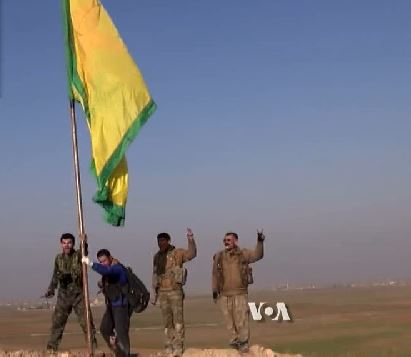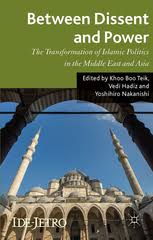IDEスクエア
世界を見る眼
(クルド問題についての緊急レポート)The Rise of the Kurds in the Syrian Conflict
PDF版ダウンロードページ:http://hdl.handle.net/2344/00049764
October, 2017
The Kurds form the largest non-Arab and predominantly Sunni ethnic minority in Syria. At more than 2 million people they make up 10 to 12 percent of the Syrian population. The Kurds have their own distinct language and history dating back thousands of years. The Kurds in Syria and other neighboring counties have been highly oppressed and marginalized since the formation of the nation states in the Middle East after World War I. With the consolidation of Arab nationalist states, the Kurds had very little space to organize for their cultural, political and economic rights. Arab nationalism aimed at consolidating the state by unifying Arabic-speaking Sunni and Shi'a but excluding non-Arab minorities. Syria's Arab nationalism also assumed the Arabization of minorities such as the Kurds. The Kurds were seen as a threat to "Arab unity." Fearing the regime's repression, Kurdish political parties, which dated back to 1957, operated in secrecy.1 Moreover, the discovery of major in oilfields in Kurdish areas in 1957 heightened the Syrian regime's fear of Kurdish separatism. Thousands of Syrian Kurds were classified as non-citizen foreigners and as a result they could not own property or obtain government jobs while tens of thousands were not recognized officially and had no identity cards.2 Inspired by the autonomy enjoyed by Iraqi Kurds, the Kurdish populated areas in eastern Syria experienced major unrest in in 2004. Massive demonstrations took place in Kurdish cities but they confronted the army and other security forces who killed tens of Kurds, injured hundreds, and detained around 2,000 (Human Rights Watch, March 18, 2014).3 The unrest led to further repression of the Kurds' cultural and political expressions.
Compared to their counterparts in Turkey and Iraq, the Kurdish population in Syria received less attention before the Arab uprisings of 2010-2011. However, the Kurds have emerged from the Syrian civil war as a major power player under the leadership of Democratic Union Party (PYD) led by Salih Muslim and its armed wing, People's Protection Units (YPG) that are closely linked to the guerilla fighters of Kurdistan Worker's Party (PKK) in Turkey. In fact, the PYD was established in 2003 by former militants of the PKK of Syrian origin in northern Iraq.
Three major factors lie behind the rise of the Syrian Kurds. The first is the Syrian civil conflict and the resulting weakening of the unitary central government of the Asad regime. The second is the support the Syrian Kurds receive from the USA and other Western governments for their role in the fight against the Islamic State. The third is the Kurds' ability to govern and rule in Kurdish areas and cities captured from the Islamic States (ISIS).

The Kurds in the 2011 Syrian Uprising
The Syrian uprising against the Asad rule has evolved into a complex war for rival internal and external actors. The war made Syria a failed state and many sub-state actors took over. Syria became a breeding ground for jihadists, rebel groups and other foreign militias fighting alongside the regime forces. As a result, many Syrians sought protection within their ethnic, religious and sectarian groups. The failed state exacerbated conflicts over territorial control between actors trying to advance their alternative projects for Syria and its future. The disintegration of the Syrian state as a whole strengthened Kurdish nationalist and separatist aspirations in Syria's northeast region. Thanks to their experiences under Asad's repressive policies and the backing of the PKK military commanders, the Kurds were better than other opposition groups at organizing and defending themselves.
Almost seven months into the Syrian uprising against the Asad rule, Kurdish National Council (KNC) was formed in Erbil as an umbrella opposition group under the sponsorship of the president of the Kurdistan Regional Government of Iraq, Massoud Barazani.4 The KNC stressed Kurdish identity within a larger Syrian landscape. In August 2013, the KNC joined the Syrian National Council. The KNC's rival, PYD, however, had pragmatically struck a deal with the Asad regime by which the regime spared the Kurdish areas of destruction while the PYD's police (Asayish) suppressed anti-Asad demonstrations. Hence, the PYD was allowed to rule. In 2012, Asad offered concessions to convince the Kurds to stay out of the uprising. He issued a decree granting nationality to tens of thousands of stateless Kurds in Syria's eastern Hasaka region. Later in the same year the Asad government withdrew its forces from a large territory along the Turkish border. This move allowed the PYD to take administrative and military control of Efrin, Kobani, and al-Jazeera, collectively named Western Kurdistan (Rojava in Kurdish). It also allowed Asad's security forces to concentrate on the opposition elsewhere and sow dissention among anti-government groups. The regime also calculated that the Kurdish presence on the Turkish border would complicate the Turkish government's efforts to arm and work with anti-Asad forces.
In fact, the PYD-Asad relations date back to the 1980s and 1990s when former Syrian president Hafez al-Asad supported PKK's insurgency against Turkey. Many PKK's fighters held Syrian citizenship and Asad's support of PKK allowed PYD members to gain years of experience in organizing and fighting the Turkish state. At the start of the Syrian conflict, therefore, the PYD was better off its Kurdish rivals since its strong party structure and military wing (YPG) enabled the PYD to impose order and security in the areas it controlled, and pursue a pragmatic approach towards the uprising, the regime, and regional and international actors.
Shortly after the Russian government announced a partial withdrawal from Syria in March 2016, the PYD declared the formation of a democratic federalism by building a semi-autonomous region and centralizing governance in the three Kurdish majority areas of Western Kurdistan, in northeast Syria along the Turkish border. The democratic federalism drew from the political vision of PKK's founder and leader, Abdullah Ocalan, who has been imprisoned in Turkey since 1999. Since taking control of these areas, the PYD drafted a constitution, held elections, and established numerous local councils. To gain international recognition and support, and to appease Turkey, PYD denies having organizational links with PKK which is designated a terrorist organization by Turkey, USA, and many other Western governments. Without a political settlement, however, the Kurds'self-declared autonomous region has not been recognized by any local, regional or international power, and might become a new site of fighting whether the Asad regime departs or not. While it is predominantly Kurdish, Rojava is an ethnically mixed region with a sizeable Arab Muslim and Christian minority. Moreover, Syria's Kurdish region contains large oilfields, notably in Rumailan and Suwaidiyah, which might spark future conflict over energy security and the distribution of wealth among social forces in the region.
The PYD and the Fight against ISIS
The rise of the Syrian Kurds has strong regional and international dimensions. As Turkish-Syrian relations reverted to enmity in the aftermath of the Syrian uprising, the Asad regime decided to allow the PKK and PYD to operate inside Syria. On its part, Ankara hosted the Free Syrian Army and the Syrian Muslim Brothers. As in the 1980s and 1990s, the Kurdish question arose as a bargaining chip against Turkey5.
In fact, the YPG, is considered to be the most effective force fighting ISIS and Al-Qaeda in Syria. For almost a year ISIS tried to seize Kubane (Ain al-Arab in Arabic) in northern Syria near the border with Turkey. The battle for Kubane was important for the international community. With US support, the Kurds made sure Kubane did not fall into the hand of ISIS. In January 2015, ISIS was defeated and lost hundreds of fighters there. Since then the Kurdish forces, estimated at 20,000 in Syria, are the most trusted in the USA-led anti-ISIS coalition due to their ability to stabilize and govern areas taken from ISIS6. The PYD has increasingly emerged as a key Western ally with regional influence.
However, there is not much trust between the Kurdish forces and the local populations. There is strong sentiment among the local population that the Kurds have expanded at the expense of the local population because the Kurds have their own political project of establishing a separatist autonomous region. This may lay the groundwork for future ethnic conflicts between Kurds and Arabs. Furthermore, Human Right Watch has documented human rights abuses in PYD-controlled areas7. To bridge the mistrust between the Arabs and Kurdish forces, and to separate (at least in theory) the YPG and the PKK, so that it can continue arming the YPG, the USA created a joint Arab-Kurdish-Syriac Christian force at the start of the Battle of Kubane in 2014. The USA recruited more than 3,000 Arabs to join a 2,000 Kurdish forces in the so-called Syrian Democratic Forces (SDF) that is dominated and controlled by the Kurdish YPG. The PYD is well aware that it needs other international partners in case the defeat of ISIS results in a scaling back of US support for PYD. By balancing its relations with the Syrian regime, Russia, and USA, the PYD has been able to bolster its military capabilities and insulate itself against direct aggression from Turkey.
In fact, like USA, Russia views PYD and YPG as the key to fight groups, such as Ahrar al-Sham and al-Nusra, that oppose the Syrian regime. The PYD's cutting of the Aleppo-Turkey connection enabled the Syrian regime to regain control of eastern Aleppo in July 2016 with the support of the Lebanese Shi‘it group Hezbollah, Iraqi and Iranian Shi‘it militias and Russian airstrikes (Reuters, December 14, 2016). Russia has offered Rojava a significant amount of military assistance and the PYD's leader visited Moscow where he opened a PYD representation8. Russia's draft constitution for Syria clearly backs the Kurds' demand for a decentralized Syrian state and the empowerment of local councils9. Although Russian denied it, the PYD claimed in March 2017 that Russia was setting up a military base in northeastern Syria and would train PYD fighters (Ekurd Daily, March 20, 2017). This move brought Russia and USA, otherwise international rivals, to the PYD's side. By helping the PYD to fight against ISIS, Russia demonstrates that it also fights terrorism at the international level. By supporting the PYD in Syria, Russia can also intervene in Turkey's "Kurdish problem" by establishing a direct connection with the PKK through the PYD.
The PYD-controlled Rojava is important to Russia for three main reasons: 1. It gives Russia permanent leverage in Syrian politics; 2. It provides Russia with permanent troop bases; and, 3. Rojava's proximity to Turkey provides Russia with leverage against Turkish president, Rajab Tayeb Erdogan10. These reasons explain Russia's insistence on including the PYD in intra-Syrian peace talks in Geneva and Turkey's firm opposition to PYD's presence in peace talks between the opposition and the Asad regime.
The Syrian Kurds'Self-Rule
The PYD has been one of the main non-state beneficiaries of the civil war in Syria and the fight against ISIS and other Islamists. Indeed, the Syrian Kurds practically operate on their own beyond the control of Asad or any other Syrian force. With its new local councils elected on September 22, few days before the Kurdistan independence referendum was held on September 25, 2017, the PYD has de facto self-rule in Rojava. Its next step is to elect the first regional parliament in early 2018.
Many Kurds in northern Syria celebrated their neighbors'independence referendum while Syria's foreign minister, Walid al-Muallem, stated that the Syrian government was open to negotiations with the Kurds over their demands for autonomy within Syria's borders (Reuters, September 26, 2017). Yet, while the Kurdistan independence referendum have stoked Syrian Kurds'nationalist aspirations, they realize that if they seek independence, they will have to expect military confrontation with Turkey, which conducted military operations against the PYD in northern Syria over the past few years and might launch outright invasion. In fact, Syrian rebel groups, Asad, and Syria's neighboring states oppose the breakup of Syria or any threat to the territorial integrity of the existing states. For that matter, both USA and Russia oppose Kurdish independence while USA and Western states may not maintain post-ISIS support for the Syrian Kurds. Consequently, retaining autonomy may be the Kurds'most pragmatic and practicable in the coming years.
(Finish writing 14 October, 2017)
著者プロフィール(Author's Profile)
Housam Darwisheh is Research Fellow at the Institute of Developing Economies (IDE-JETRO). He earned a PhD in 2010 from the Graduate School of Area and Cultural Studies, Tokyo University of Foreign Studies. He specializes in the comparative politics of the Middle East and North Africa. His current areas of research interest include social movements and Islamic politics in Egypt and Tunisia, state formation and implosion in Syria and Libya, and the impacts of the restructuring of regional order on the politics of different Middle Eastern countries.
脚注
- Christian Sinclair and Sirwan Kajjo, "The Evolution of Kurdish Politics in Syria," MERIP, August 31, 2011.
- Michael M. Gunter. 2014. Out of Nowhere: The Kurds of Syria in Peace and War, Hurst and Company, London. UK.
- "Syria: Address Grievances Underlying Kurdish Unrest ": https://www.hrw.org/news/2004/03/18/syria-address-grievances-underlying-kurdish-unrest (accessed October 1, 2017)
- "The Kurdish National Council in Syria," Carnegie Middle East Center:
http://carnegie-mec.org/syriaincrisis/?fa=48502 (accessed October 3, 2017). - Marwa Daoudy. 2016. The Structure-Identity Nexus: Syria and Turkey's Collapse (2011), Cambridge Review of International Affairs, 29 (3): 1074-1096.
- Emily Burchfield. February 7, 2017. "PYD Governance in Northeastern Syria," Syria Source, Atlantic Council.
- "Under Kurdish Rule: Abuses in PYD-Run Enclaves of Syria," June 19, 2014 https://www.hrw.org/report/2014/06/19/under-kurdish-rule/abuses-pyd-run-enclaves-syria (accessed October 1, 2017).
- "Syrian Kurdistan mission opens in Moscow," Russian TV. February 10, 2016: https://www.rt.com/news/332077-kurdish-representative-office-moscow/
(accessed October 5, 2017). - Maxim A. Suchkov. May 6, 2016. "How Russia sees Kurdish quest for autonomy," Al-Monitor: http://www.al-monitor.com/pulse/originals/2016/05/russia-syria-iraq-kurds-quest-autonomy.html (accessed October 4, 2017).
- Andrew J. Tabler, Soner Cagaptay, David Pollock, and James F. Jeffrey. March 2016. "The Syrian Kurds: Whose Ally?," The Washington Institute: http://www.washingtoninstitute.org/policy-analysis/view/the-syrian-kurds-whose-ally
(accessed September 28, 2017).



